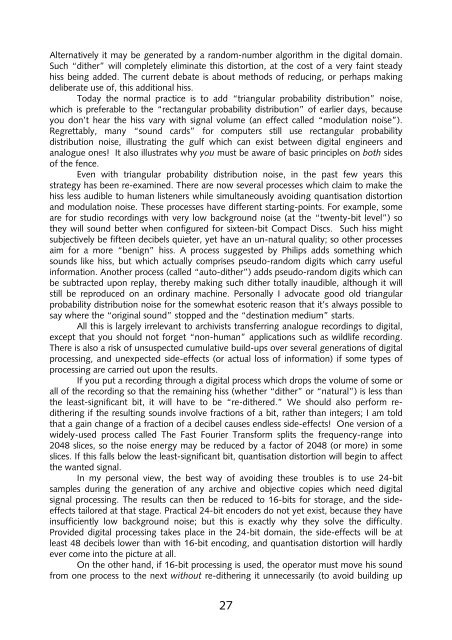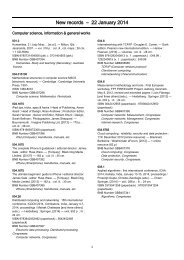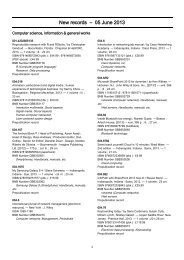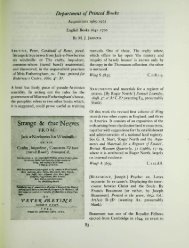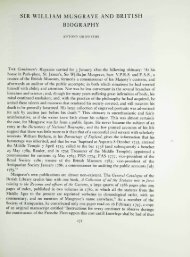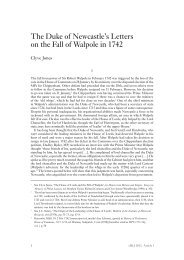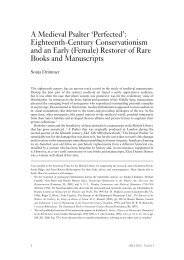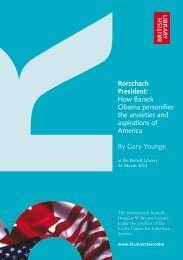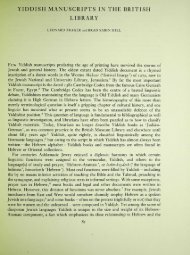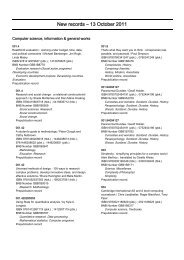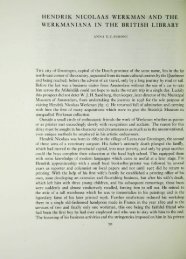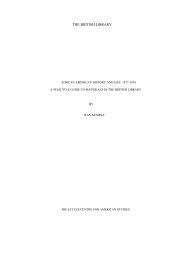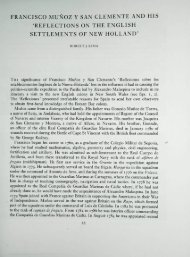MANUAL OF ANALOGUE SOUND RESTORATION ... - British Library
MANUAL OF ANALOGUE SOUND RESTORATION ... - British Library
MANUAL OF ANALOGUE SOUND RESTORATION ... - British Library
Create successful ePaper yourself
Turn your PDF publications into a flip-book with our unique Google optimized e-Paper software.
Alternatively it may be generated by a random-number algorithm in the digital domain.<br />
Such “dither” will completely eliminate this distortion, at the cost of a very faint steady<br />
hiss being added. The current debate is about methods of reducing, or perhaps making<br />
deliberate use of, this additional hiss.<br />
Today the normal practice is to add “triangular probability distribution” noise,<br />
which is preferable to the “rectangular probability distribution” of earlier days, because<br />
you don’t hear the hiss vary with signal volume (an effect called “modulation noise”).<br />
Regrettably, many “sound cards” for computers still use rectangular probability<br />
distribution noise, illustrating the gulf which can exist between digital engineers and<br />
analogue ones! It also illustrates why you must be aware of basic principles on both sides<br />
of the fence.<br />
Even with triangular probability distribution noise, in the past few years this<br />
strategy has been re-examined. There are now several processes which claim to make the<br />
hiss less audible to human listeners while simultaneously avoiding quantisation distortion<br />
and modulation noise. These processes have different starting-points. For example, some<br />
are for studio recordings with very low background noise (at the “twenty-bit level”) so<br />
they will sound better when configured for sixteen-bit Compact Discs. Such hiss might<br />
subjectively be fifteen decibels quieter, yet have an un-natural quality; so other processes<br />
aim for a more “benign” hiss. A process suggested by Philips adds something which<br />
sounds like hiss, but which actually comprises pseudo-random digits which carry useful<br />
information. Another process (called “auto-dither”) adds pseudo-random digits which can<br />
be subtracted upon replay, thereby making such dither totally inaudible, although it will<br />
still be reproduced on an ordinary machine. Personally I advocate good old triangular<br />
probability distribution noise for the somewhat esoteric reason that it’s always possible to<br />
say where the “original sound” stopped and the “destination medium” starts.<br />
All this is largely irrelevant to archivists transferring analogue recordings to digital,<br />
except that you should not forget “non-human” applications such as wildlife recording.<br />
There is also a risk of unsuspected cumulative build-ups over several generations of digital<br />
processing, and unexpected side-effects (or actual loss of information) if some types of<br />
processing are carried out upon the results.<br />
If you put a recording through a digital process which drops the volume of some or<br />
all of the recording so that the remaining hiss (whether “dither” or “natural”) is less than<br />
the least-significant bit, it will have to be “re-dithered.” We should also perform redithering<br />
if the resulting sounds involve fractions of a bit, rather than integers; I am told<br />
that a gain change of a fraction of a decibel causes endless side-effects! One version of a<br />
widely-used process called The Fast Fourier Transform splits the frequency-range into<br />
2048 slices, so the noise energy may be reduced by a factor of 2048 (or more) in some<br />
slices. If this falls below the least-significant bit, quantisation distortion will begin to affect<br />
the wanted signal.<br />
In my personal view, the best way of avoiding these troubles is to use 24-bit<br />
samples during the generation of any archive and objective copies which need digital<br />
signal processing. The results can then be reduced to 16-bits for storage, and the sideeffects<br />
tailored at that stage. Practical 24-bit encoders do not yet exist, because they have<br />
insufficiently low background noise; but this is exactly why they solve the difficulty.<br />
Provided digital processing takes place in the 24-bit domain, the side-effects will be at<br />
least 48 decibels lower than with 16-bit encoding, and quantisation distortion will hardly<br />
ever come into the picture at all.<br />
On the other hand, if 16-bit processing is used, the operator must move his sound<br />
from one process to the next without re-dithering it unnecessarily (to avoid building up<br />
27


